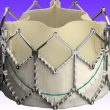There is an important group of patients presenting low flow, low-gradient severe aortic stenosis (defined as mean gradient <40 mmHg). This is why we do dobutamine stress echocardiogram (DSE), to confirm whether we are dealing with truly severe aortic stenosis. However, it might not be well tolerated and a CT angiography will be done to...
The most read scientific articles in interventional cardiology in March on our website
Below, we share March’s most read scientific abstracts in interventional cardiology at solaci.org. ACC 2023 | YELLOW III Study. Effect of Evolocumab on Coronary Plaque Characteristics in Stable Coronary Artery Disease Dr. Kini presented the results of the YELLOW III Study where she analyzed the effect of evolocumab on coronary plaque in patients with stable...
MitraScore: What Does the Final Result of Edge-to-Edge Treatment of Mitral Regurgitation Provide?
Edge-to-edge treatment has proven to be a safe and effective technique in follow-up, decreasing mortality and hospitalizations for heart failure when a good result is achieved. The MitraScore was developed to assess the outcome at the end of the procedure. In that sense, results <3 represent mild mitral regurgitation, which would be related to lower...
Vascular Ultrasound in Percutaneous Closure Devices: Subanalysis of the UNIVERSAL-Trial
Analysis of percutaneous closure device placement when choosing an ultrasound-guided vs. a fluoroscopy-guided femoral approach. Transradial access is the access of choice in percutaneous coronary interventions, with a demonstrated benefit in mortality and bleeding when compared with transfemoral access. The latter, however, is still the access of choice in cases where large caliber introducers are...
Intracoronary Brachytherapy for Drug-Eluting Stent Restenosis
3 Year Clinical Outcome Analysis and Failure Predictors in the Use of Intracoronary Brachytherapy for Drug-Eluting Stent Restenosis In-stent restenosis (ISR) has been one of the greatest obstacles standing in the way of long term patency in percutaneous coronary interventions. However, the use of drug eluting stents (DES) and their development has helped reduce ISR...
The most read articles of january in solaci.org
These were the most read articles of interventional cardiology in solaci.org. Real-World Revascularization Strategy for Left Main Coronary Artery: Surgery or PCI? There are many current randomized trials comparing percutaneous coronary intervention (PCI) with myocardial revascularization surgery (MRS) for the treatment of left main coronary artery disease (LMCAD). Real-World Results of Different Devices for TAVR Transcatheter aortic valve replacement (TAVR) keeps...
Can Drug Coated Balloon Be a Valid Option for Small Vessels?
One of the challenges of percutaneous coronary interventions (PCI) are <2.5 mm vessels, since complications and restenosis complications rate are higher than with >3.0 mm vessels. Drug Coated Balloons (DCB) can be a useful tool, but their efficacy and safety [vs. plain old balloon angioplasty] remains unclear. PEPCAD China SVD is a prospective and multicenter...
Ticagrelor or Prasugrel Post-PCI in Daily Practice Patients
The ISAR-REACT 5 showed a significant reduction in the composite outcome of death, acute myocardial infarction (AMI), or stroke when using prasugrel vs. ticagrelor in patients with acute coronary syndrome (ACS), mainly at the expense of an AMI reduction. While this study changed clinical practice, it has stirred some criticism regarding certain methodological aspects, such...
Valve-in-Valve Shows Good Evolution after 2 Years
The degeneration of bioprostheses in aortic position occurs at approximately after 10 to 15 years. In this scenario, the treatment of choice used to be redo surgery, but with the evolution of transcatheter aortic valve replacement (TAVR), it became a valid alternative with a level IIa B evidence. While there are currently multiple analyses of...
Long-Term Mortality in Non-Obstructive Lesions in the Left Main Coronary Artery
Left main coronary artery (LMCA) intervention with significant lesions on both coronary angiography and intravascular ultrasound (IVUS), either through angioplasty (PCI) or myocardial revascularization surgery (MRS), is directly related to a decrease in long-term adverse clinical events. However, the relationship between subclinical LMCA disease (preserved luminal diameters) and long-term mortality is still unknown. A retrospective...









